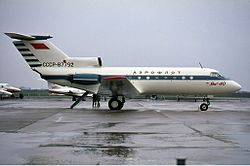This article has multiple issues. Please help improve it or discuss these issues on the talk page. (Learn how and when to remove these messages)
|
Aeroflot Flight B-608 was a scheduled flight from Irkutsk to Bratsk, which on May 4, 1972, the Yakovlev Yak-40 crashed when it suffered a microburst, leading for the aircraft to nosedive and crashing near the airport, killing the 18 occupants onboard.
 An Aeroflot Yakovlev Yak-40, similar to the aircraft involved in the accident | |
| Accident | |
|---|---|
| Date | May 4, 1972 |
| Summary | Microburst; loss of control. |
| Site | near Bratsk Airport, USSR 56°21′35″N 101°44′28″E / 56.35972°N 101.74111°E |
| Aircraft | |
| Aircraft type | Yakovlev Yak-40 |
| Operator | Aeroflot |
| Registration | CCCP-87778 |
| Flight origin | Irkutsk Airport |
| Destination | Bratsk Airport |
| Occupants | 18 |
| Passengers | 14 |
| Crew | 4 |
| Fatalities | 18 |
| Survivors | 0 |
Aircraft
editThe Yak-40, with tail number 87778 (manufacturer serial number - 9040314, serial number - 14-03), had been produced by the Saratov Aviation Plant on October 30, 1970, and transferred to the Ministry of Civil Aviation of the USSR, which on December 30 assigned it to the Bratsk Aviation Department of the East Siberian Civil Aviation Directorate. The cabin had a seating capacity of 24 passengers. At the time of the crash, the airliner had logged 1,667 flight hours and 2,249 landings.[1][2]
Accident
editThe aircraft was performing flight V-608 from Irkutsk to Bratsk, piloted by a crew from the 245th flight squadron, consisting of the commander (PIC) Ivan Andreevich Ivanov, copilot Valery Ivanovich Bulanov, flight engineer Oleg Vasilyevich Stolyarov, and trainee flight engineer Valery Ivanovich Nosarev. At 22:29, the Yak-40 departed from Irkutsk Airport and, after climbing, leveled off at a flight level of 6,000 meters. There were 14 passengers on board.[2]
Upon approaching Bratsk, the crew contacted the airport dispatcher, and, after receiving permission, began their descent. The dispatcher attempted to relay information about the actual weather, but despite several attempts, could not get a response from the observer at the AMS, so he transmitted the weather data as of 23:15: runway visibility 50 kilometers, no precipitation. Meanwhile, the weather was rapidly deteriorating, which the dispatcher himself observed. By the time of the incident, there was already a wet snowstorm, strong wind (10–14m/s), and visibility had decreased to 1,000 meters, which was below the meteorological minimum for the commander.[2]
Unaware of the actual weather conditions, the crew lined up for the final approach when they unexpectedly encountered a snowstorm. The Yak-40 also encountered a strong downdraft, resulting in a rapid loss of altitude. The airliner clipped the tops of trees, lost speed, and crashed at 11:34pm after flying another 225 meters. The crash occurred 1,250 meters from the end of the runway. All 18 people on board died.[2]
Causes
editThe sharp descent of the aircraft from a low altitude under the influence of an intense downdraft and subsequent collision with the tops of trees during its recovery in conditions of limited visibility at night. The unexpected encounter of the aircraft with hazardous meteorological phenomena was a result of the rapid deterioration of weather conditions and insufficient promptness in observing and transmitting this information.[citation needed]
Contributing factor: possible inadvertent activation of the thrust reverser by the crew during the descent (the thrust reverser was found to be activated during the inspection of the aircraft at the crash site).[2]
References
edit- ^ "Yakovlev Yak-40 Tail Number: CCCP-87778". Russianplanes.net. Archived from the original on 2013-06-15. Retrieved 2013-06-15.
- ^ a b c d e "The crash of the Yak-40 of the East Siberian Civil Aviation Directorate near Bratsk airport". airdisaster.ru. Archived from the original on 2013-10-30. Retrieved 2013-06-15.